Exam 2
1/157
There's no tags or description
Looks like no tags are added yet.
Name | Mastery | Learn | Test | Matching | Spaced |
|---|
No study sessions yet.
158 Terms
cognitive-emotional theories of development
emphasize the role of cognitive processes and individual interpretations in shaping emotions
suggest that our emotions are not solely based on external events but are heavily influenced by how we perceive, interpret, and evaluate those events
Lewis & Lewis
ecological/contextual theories of development
emphasize the importance of the environment, context, and social interactions in shaping an individual's emotions and emotional development
propose that emotions are influenced by the broader ecological and social contexts in which individuals live
Brofenbrenner and Lerner
functionalist theories of development
focus on the adaptive and functional aspects of emotions
emotions have evolved to serve specific purposes or functions that aid an individual's survival and well-being
differential emotion theories of development
emphasize that emotions are not just simple, reflexive reactions but rather complex, organized responses that serve adaptive functions
set of 6 basic or primary emotions that serve as the foundation for the wide range of human emotions
Izard, Tomkins
psychodynamic theories of development
emphasize the role of unconscious processes, inner conflicts, and the influence of early experiences in shaping an individual's development
stage theories
Freud, Erikson
organizational theories of development
emphasizes the idea that development occurs through a series of organized, interrelated stages and processes
early caregiving experiences and attachment patterns can have long-lasting effects on an individual's emotional and social development throughout their life
Sroufe
developmental theoretical approaches
Psychodynamic (Freud, Erikson)
Organizational (Emde, Sroufe)
Differential emotions (Tomkins, Izard)
Functionalism (Camras, Campos, K Barrett, Frijda)
Cognition-emotion fusion (Micheal Lewis, Marc Lewis)
Ecological/contextual (Brofenbrenner, Lerner)
PFCOED
psychodynamic developmental theories/theorists
Freud’s theory & Erikson’s stage theory
Freud’s psychodynamic theory of emotion
there is a dynamic tension between the id and the superego
emotions affect body and mind over long term
popularized idea that childhood experience shapes adult emotional behaviour
psychodynamic Freudian stages
0-1 - oral
1-3 - anal
3-6 - phallic
6-12 - latency
12-20 - early genital
20-40 - genital
40-65 - genital
65+ - genital
stages of Erikson’s stage theory
0-1: trust vs mistrust
1-3: autonomy vs shame/doubt
3-6: initiative vs guilt
6-12: industry vs inferiority
12-20: identity vs role confusion
20-40: intamacy vs isolation
40-65: generativity vs stagnation
65+: ego integrity vs despair
social learning theory
idea that experience reinforces or punishes behaviours (emotions, thoughts, actions)
organizational developmental theories/theorists
Sroufe
Sroufe’s organizational approach
each emotion begins as a physiological prototype and differentiate into “precursors” of emotions
then eventually emerge as emotions by end of first year (due to cognitive developments)
all emotions are expression of “tension”
stages of Sroufe’s organizational approach
0-3 months - psychological regulation
3-6 months - management of tension
6-12 months - establishing an effect attachment relationship
12-18 months - exploration and mastery
18-30 months - individuation (autonomy)
30-54 months - management of impulses, sex-role identification, peer relations
6-11 years - consolidating self concept, loyal friendships, effective same-sex peer group functioning, real-word competence
adolesence - personal identity, mixed gender relationships, intimacy
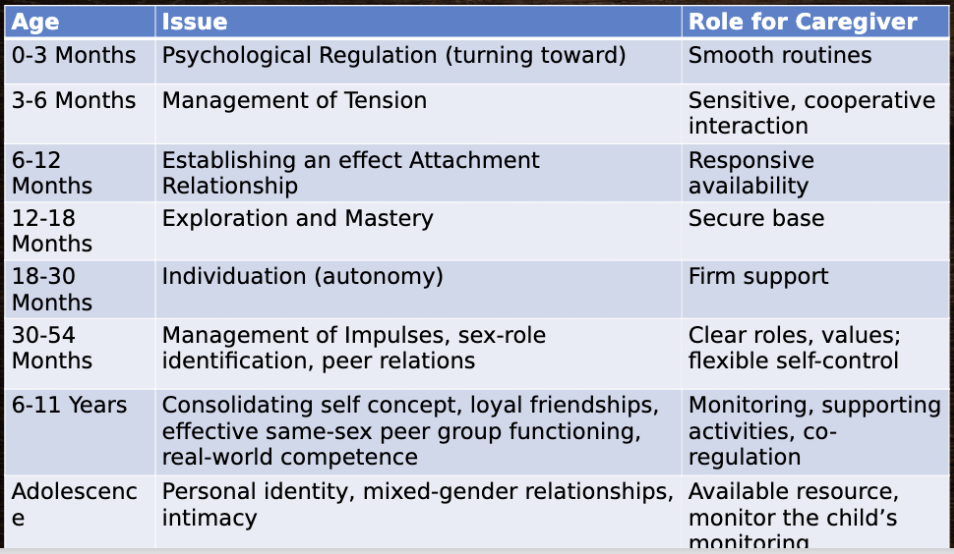
developmental differential emotion theory/theorists
associated with Izard
10 fundamental emotions present at birth
Anger, contempt, disgust, distress, fear, guilt, interest, joy, shame, surprise
emotions do not manifest until mature or adaptive
develop in parallel with cognition
developmental functionalism theory/theorists
associated with Joe Campos and Karen Barrett
emotions
function to regulate social and interpersonal behaviour through their expressive components
regulate the flow of information and the determination of response to it
regulate behaviour through innate prewired communication process
relations between a goal and perception of proximity to it
emotions and their goals in functionalism theory
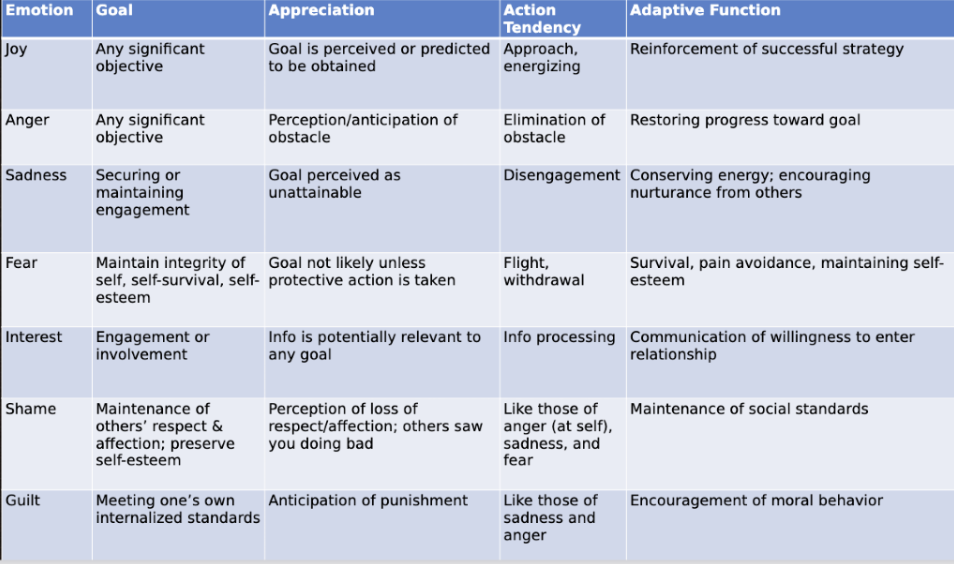
function of guilt (functionalism theory)
enocouragement of moral behavior
function of shame (functionalism theory)
maintainance of social standards
function of interest (functionalism theory)
communication of willingness to enter a relationship
function of fear (functionalism theory)
survival, pain avoidance, maintaining self-esteem
function of sadness (functionalism theory)
conserving energy; nurturance from others
function of anger (functionalism theory)
restoring progress toward goal
function of joy (functionalism theory)
reinforcement of succesful strategy
developmental cognition-emotion fusions theories/theorists
associated with Lewis and Lewis
Michael Lewis: development of self
Marc Lewis: cognition & emotion inseparable (emotions are emergent)
cognitive development drives emergence of emotions
developmental ecological theories/theorists
Brofenbrenner’s ecological model
Lerner’s developmental contextualism
Brofenbrenner’s ecological model
ecological model suggesting that an individual’s development is influenced by a series of interconnected environmental systems, ranging from the immediate surroundings (e.g., family) to broad societal structures (e.g., culture)
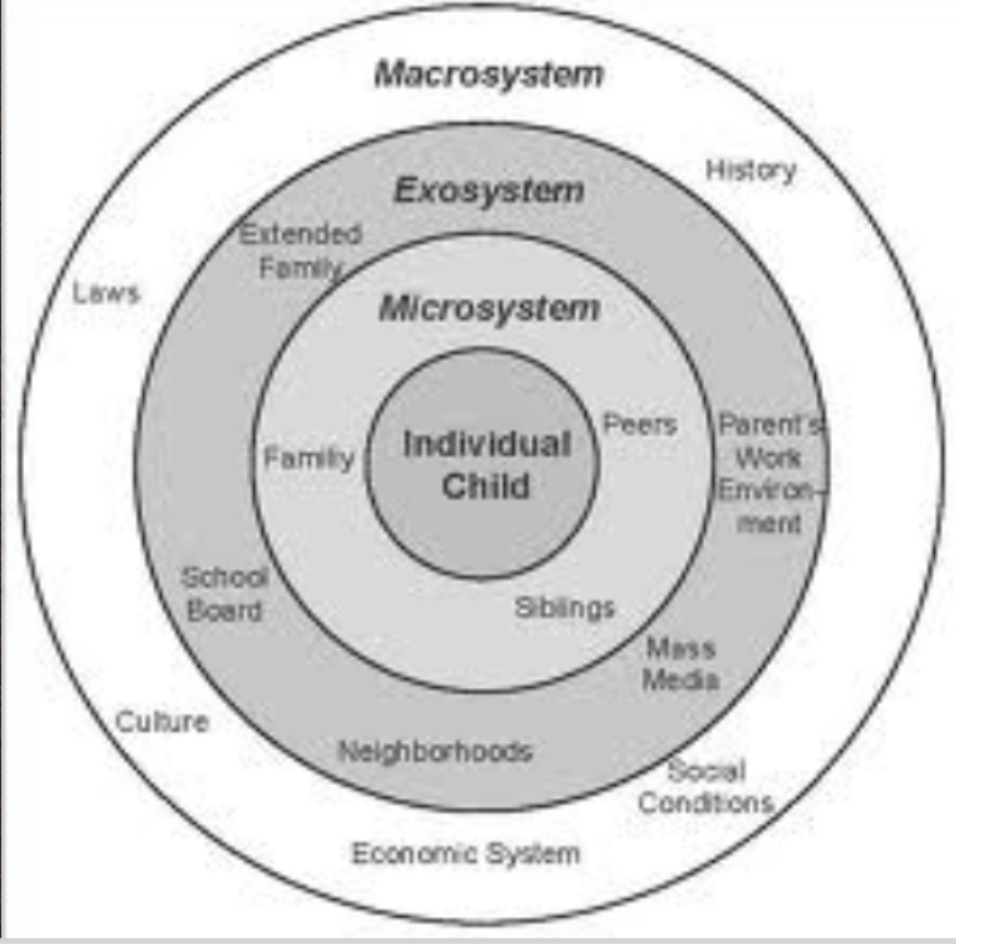
macrosystem
outer layer of Brofenbrenners ecological model
the values, traditions, and sociocultural characteristics of the broad cultural components that influence a developing child's identity, values, and perceptions
includes economic conditions of society, laws in society, taboos and customs of society, and cultural beliefs
microsystem
inner layer of Brofenbrenners ecological model
the things that have direct contact with the child in their immediate environment
includes the child’s most immediate relationships and environments (parents, siblings, teachers, classmates)
exosystem
middle layer of Brofenbrenners ecological model
consists of environmental elements that greatly affect a child's development
include a parent's workplace, mass media, school policy, social support systems, family friends, and local government policy settings
Lerner’s developmental contextualism
ecological model that states that views human development as inextricably and reciprocally linked to the multiple contexts of individuals’ lives
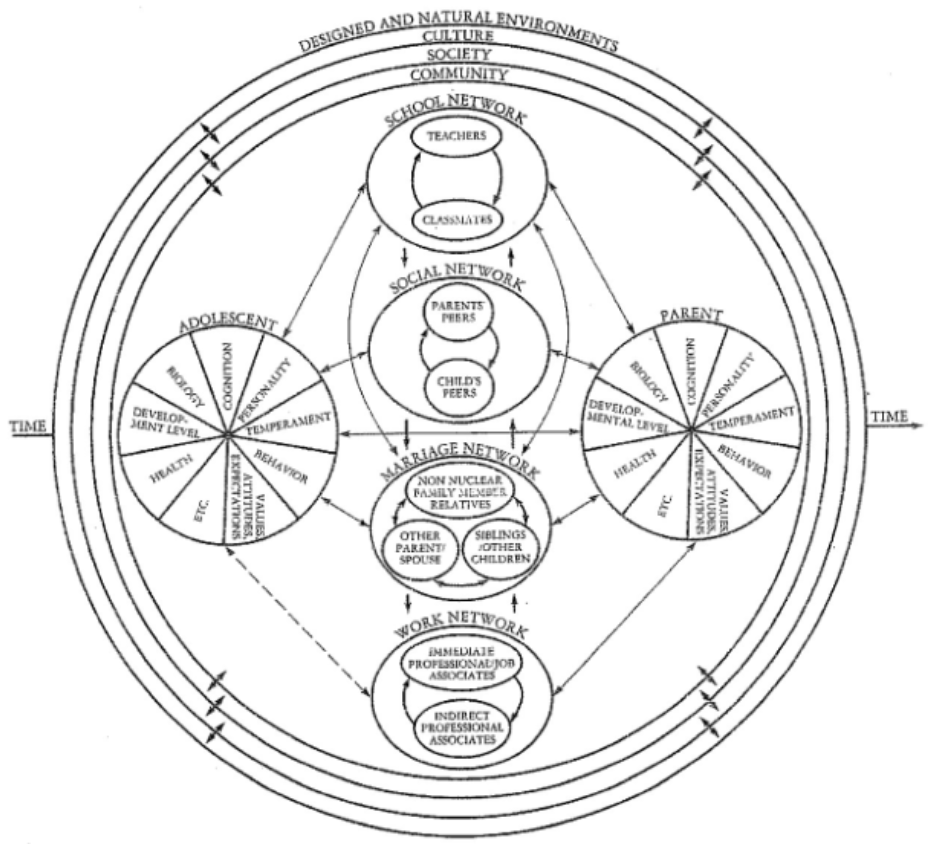
motivational expressions in infancy
crying
nonverbal, often means a core motivational need is unmet
also cry when they hear other newborns cry; this is called contagious crying
baby’s first way of getting attention and care
emotional expressions in infancy
smiling and laughing
early on - have little or no connection to the social situation
2 months of age - social smiling begins with parents and caregivers
help support affective coordination and bonding between babies and their caregivers
moro reflex - response to danger
moro reflex
a sequence in which the infant flings out its arms and spreads its fingers, then contracts quickly into a fetal position with fingers bent
described as an infant startle, and the second part of it does resemble the adult startle response
how emotions develop generally
physical maturation
cognitive maturation
social interaction
emotional development: physical maturation
immature vision does not limit their emotions, but it does limit their ability to respond to visual stimuli
being able to see = having the capacity to experience emotional events
developing abilities to crawl and walk introduce new situations with implications for emotion
increasing motor maturation also enables the infant to express emotions more clearly
emotional development: cognitive maturation
appraisal requires cognitive abilities that develop across the early months and years of life, rather than being present at birth
self-concept develops late in the second year of life
they also begin to show signs of embarrassment, shame, and guilt, all of which require seeing yourself through other people’s eyes and/or comparing yourself to their expectations
begin to develop theory of mind, the understanding that other people have minds too and that some people, including yourself, might know something that other people don’t know
emotional development: social interaction
children and their parents begin to synchronize their attention to objects, and their emotional responses to them, late in the first year of life
first, infants just respond to the parent’s emotions (primary intersubjectivity)
but later they notice what caused the parent’s reaction and then adjust their own reaction to that object or event (secondary intersubjectivity)
begin to social reference
importance of language/nonverbal expression in emotional development
without emotion vocabulary and nonverbal expression, we have no way of knowing specifically what a child is feeling
becomes easier to understand what emotion a child is feeling once the necessary vocabulary is in place
ideas for how children develop their emotion vocabulary
some propose that children learn emotion concepts and vocabulary when adults say things such as, “I’m sorry you’re feeling sad,” or “that person is angry,” labeling the emotion and using it to describe the child’s or another person’s experience
others suggest that children pick up on statistical patterns in the emotional situations, expressions, and actions of the people around them, and form specific emotion concepts (such as happiness and fear) on their own, attaching words to those concepts later on
when do children begin to recognize and respond appropriately to emotions expressed by other people
three years of age
when do early signs of emotional self-regulation emerge
can be seen in the second year of life
totipotent
how early cells are
the ability to be absolutely and and every cell
later cells differentiate towards specific function
infancy development is considered the ___ year
first
development of emotion differentiation
process by which emotions specify and transform over infancy
progress from undifferentiated to differentiated
distress → anger, sadness, fear
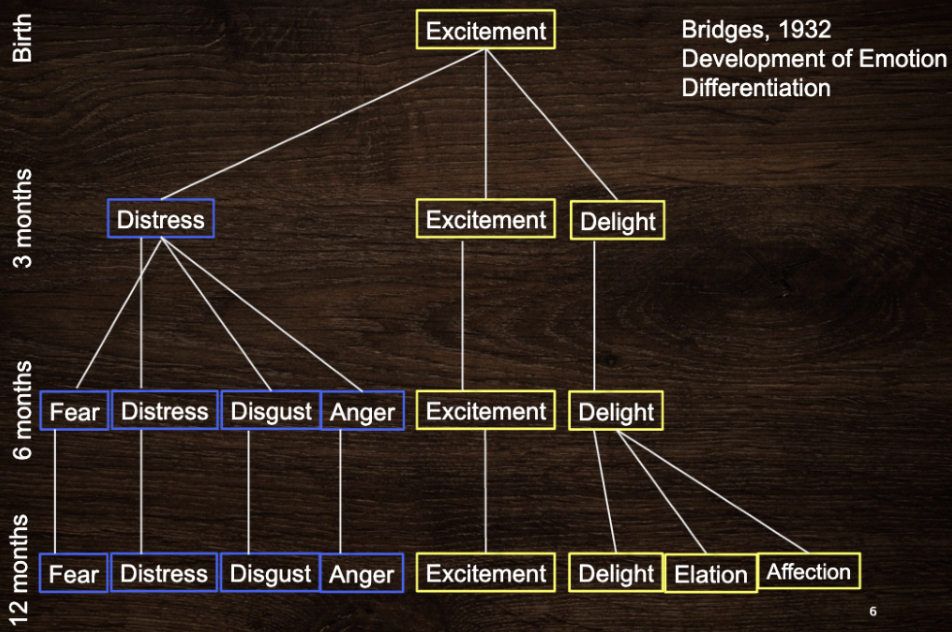
development @ 0-1 months: organizational approach
physiological regulation
distress due to restraint/discomfort, startle/pain
obligatory attention
endogenous smile
development @ 0-1 months: stage theory (Erikson)
trust vs mistrust
development @ 0-1 months: cognitive emotional perspective (Lewis)
undifferentiated sense of self
development @ 0-1 months: functionalist perspective (Campos)
simple goal blockage
development @ 0-1 months: stage theory (PIAGET)
reflex activity
development @ 0-1 months: constructivist perspective (LF Barrett)
affect: arousal and violence
development @ 1-3 months: organizational approach (Sroufe)
coordinating attention and activity
reliable (exogenous) social smile
development @ 1-3 months: stage theory (Erikson)
trust vs mistrust
development @ 1-3 months: cognitive emotional perspective (Lewis)
joy, disgust, and sadness emerge
possibly anger
development @ 1-3 months: functionalist perspective (Campos)
simple goal blockage
development @ 1-3 months: stage theory (PIAGET)
primary circular reactions
development @ 1-3 months: constructivst perspective (LF Barrett)
affect: arousal and valence
developmental onsets @ 6-9 months
social engagement
discriminate familiars from strangers
peakaboo and humor (violated predictions)
anger, fear, sadness
developmental onsets @ 9-12 months
seperation anxiety and stranger anxiety
crawl-to-walk: travel broadens the mind
mama and dada
key development in the first year
goals and regulation
all development in the first year is guided by….
social interactions
endogenous smile
early smiling system
a spontaneous or reflexive smile that is observed when an infant, early in life, is in a state of REM sleep
characterized by a simple turning up of the corners of the mouth, such smiles are seen from birth and are not elicited by social stimulation
exogenous smile
smile that is triggered by external stimuli; social smile
Harry Harlow’s ideas on attachment
showed that infant monkeys looked for comfort in the fluffy surrogate mother, even if that surrogate mother never provided food
allowed researchers to conclude that infants feel an attachment toward their caregiver
mother as a “secure base”
what did Bowlby and Ainsworth do
developed attachment theory
Bowlby and Ainsworth ideas about attachment
attachment styles that children form based on their early interactions with caregivers form a continuum of emotion regulation
developed attachment categories
anxious avoidant attachment - infant/toddler reaction to seperation
some exploration but does not care about observer
distressed when caregiver departs
avoids mom upon return
anxious avoidant attachment - caregiver characteristics
consistently disengaged
needs not met
secure attachment - infant/toddler reaction to seperation
explores freely when mom is present
engage with observer
upset when mom departs
happy when she returns
secure attachment - caregiver characteristics
engaged
needs met
clear contingencies
anxious-resistant/ambivalent attachment - infant/toddler reaction
anxious about exploration and observer
distressed when caregiver departs
ambivalent; wants to be close but is resentful
anxious-resistant/ambivalent attachment - caregiver characteristics
engaged, but on caregivers terms (inconsistent)
needs sometimes met
disorganized attachment - infant/toddler reaction
erratic and unpredictable
disorganized attachment - caregiver characteristics
erratic and unpredictable
issues with attachment
there are many different attachment relationships
individuals may change categories - one study found that on 29% of people retained the same classification across all the time points
dependent on cultural context
may be mistaken with temperament
attachment across development
relationships at any age involve attachment
individual differences get more complex but still just as important
reflects child’s expectation about social world
good relationships = good physical and mental health
when does attachment emerge
six to nine months of age
infants develop the capacity to form more intense and selective emotional bonds with a few special people
Bridges (1932) development of emotional differentiation
proposed that emotions begin undifferentiated with one major “emotion” - excitement
further gets broken down and differentiated into a greater number of emotions (e.g. excitement → distress → fear, sadness, anger, disgust)
(e.g. excitement → delight → elation and affection)

mimicry occurs at around…
0-1 months
facial recognition and preference and distinguishing facial affect occurs around…
1-3 months
attachment definition
a long-lasting emotional bond to a regular caregiver, producing a desire to be near that person (and distress when separated), a tendency to turn to that person when threatened, and a sense of being supported in exploring new thing
three main behavioral manifestations of attachment
proximity seeking
safe haven
secure base
proximity seeking
behavioral manifestation of attachment
producing a desire to be near the person/caregiver/attachment
safe haven
behavioral manifestation of attachment
an instinct to turn to that person/caregiver/attachment when threatened
secure base
behavioral manifestation of attachment
a sense of security and confidence in exploring new things
strange situation
a research procedure for studying attachment in which a child is repeatedly separated from and reunited with the attachment figure
what is the relationship between an infant’s developing motor skills and attachment behavior?
between 6 and 9 months, most babies learn to crawl, and they begin their rush to explore the world
new skill opens doors to all sorts of new experiences including, unfortunately, getting lost, tumbling down the stairs, touching something sharp etc…
the attachment system helps newly mobile babies balance these two competing needs (the thrill of exploration and the risk of getting into serious trouble)
behavioral mechanisms of parent-infant attachment formation
behavioral synchrony
matching facial expressions
turn-taking with vocalizations
biological mechanisms of parent-infant attachment formation
strong evidence suggests that oxytocin is a biological mechanism for bonding between infants and their caregivers
brain uses OT as a neurotransmitter to facilitate maternal behaviors
skin-to-skin touch releases oxytocin, which in turn facilitates attachment and bonding
endorphins
1987 definition of temperament
consists of relatively consistent, basic dispositions inherent in the person that underlie and modulate the expression of activity, reactivity, emotionality, and sociability.
major elements are present early in life, and those elements are likely to be strongly influenced by biological factors.
as development proceeds, the expression of it increasingly becomes more influenced by experience and context
new perspectives on temperament
not all temperament traits are stable early in life, traits become more consistent with age
affective and cognitive processing are highly integrated systems and that, therefore, some aspects of temperament—such as attention and executive control—involve individual differences in domains traditionally considered more cognitive in nature
temperament should no longer be viewed as biologically derived at birth and later shaped by experience; rather, it should be viewed as the result of biological and environmental factors working together throughout development
further directions for the nature of temperament
how is temperament structured
what is the relation between temperament and personality traits
how do temperament traits and context interact to predict behavior in specific situations
how do temperament and the environment interact to shape developmental outcomes over time
how are changes in temperament related to biological and psychological processes?
genetics and temperament is mainly an _____ perspective
essentialist
what is temperament
stable, early appearing individual differences in behavioral tendencies that have a constitutional (consistent/essentialist) basis
what are Thomas & Chess’s temperament indicators
behavioral domains/dimesions
indicators of one’s temperament
Thomas & Chess’s NINE temperament indicators
activity
rhythmicity
approach-withdrawal
mood
intensity
adaptability
distractibility
persistence of attention
threshold
ADAPT ARMI

what did Rothbart do to Thomas & Chess’s temperament indicators
consolidated them to make them better and more concise
Rothbart SIX temperament indicators
activity
smiling and laughter
fear
soothability
distress to limitation
undisturbed persistence
what did Buss & Plomin do do Rothbart’s revised temperament indicators
FURTHER consolidated it into 3 indictaors